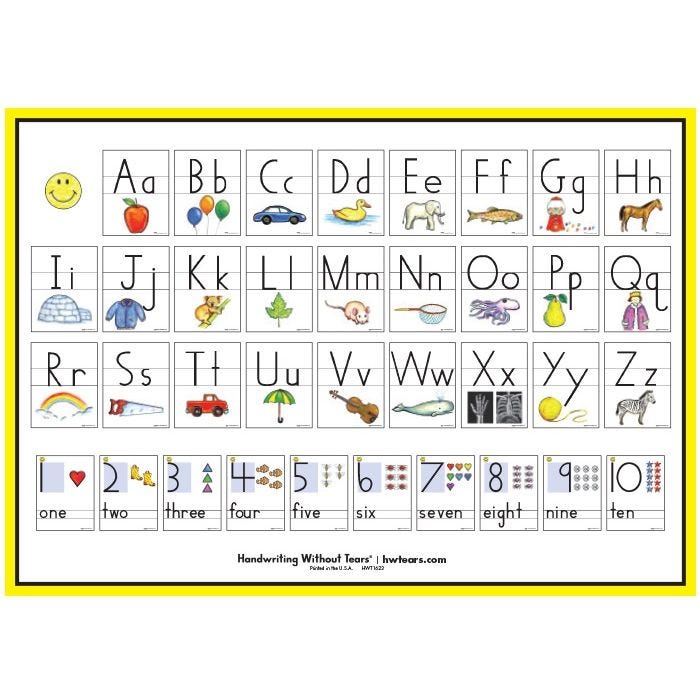Handwriting Without Tears Second Grade Hands-On Materials

| ITEM# | PRODUCT NAME | AVAILABILITY | PRICE | QTY/ACTIONS |
|---|---|---|---|---|
| 1002712 |
Blackboard with Double Lines
Excluded from Promotions |
Ships Soon |
$16.99
|
|
| 1002718 |
Color Name Plates
Excluded from Promotions |
In Stock |
$17.99
|
|
| 89951 |
Print Letter and Number Wall Cards
Excluded from Promotions |
In Stock |
$31.99
|
|
| 1002740 |
Print Letter and Number Poster
Excluded from Promotions |
In Stock |
$11.99
|
|
| 1002738 |
Print Alphabet Desk Strips
Excluded from Promotions |
In Stock |
$4.69
|
Product Description
Features:
- Lessons align with the Common Core State Standards (see Documnets tab for more information)
- Technology links for lesson extensions and support
- Home links to facilitate school-to-home connection
- Video links to demonstrate lessons and activities
- Curriculum connections
- More to Learn to extend each lesson
- Extended teaching guidelines to incorporate handwriting all year
- ELL and support strategies provide suggestions for modifying or reinforcing a lesson
The printing program for second grade is a complete review of numbers, capitals, and lowercase letters with hands-on activities and lessons that integrate important language arts skills, including sentence, word, and paragraph composition.
Blackboard with Double Lines
Use 10" x 17" board to teach students to make and place all letters on double lines in both printing and cursive. Teach name in print and cursive, letter placement on double lines, and cursive connections.
Little Chalk Bits
Great for little hands. They make writing on the Slate and Blackboard fun while helping children develop hand coordination and fine motor skills. 200 - 1" chalk bits.
Little Sponge Cubes
Just the right size for doing Wet–Dry–Try on the Slate Chalkboard and Blackboard with Double Lines. 100 square cubes, 0.5” each.
Color Name Plates
Give children practice writing their name. These name plates are a great visual aid to help teach children how to write their names. Perfect for desks, lockers, or cubbies. Double lines extend across the name space to provide an easy way for kids to learn the correct start, placement, and proportion of letters. A border features colorful mini alphabet cards that include an illustration that matches the beginning sound. Set of 30 on 11” x 3-1/2" card stock.
Color Print and Number Wall Cards
Eye-catching, illustrated cards promote correct formations. Includes 36 color letter and number cards. Cards are 8-1/2" x 11". (Same illustrations as Print Letter and Number Poster)
Print Letter and Number Poster
Colorful poster showcasing all uppercase and lowercase letters and numbers 1 -10 with charming illustration for each. 34" x 24".
Print Alphabet Desk Strips
Place these adhesive strips on student desks as a visual cue for letter formation. One sheet of 4 desk strips. Each strip is 10-1/2” x 2”.
Double Line Sentence Strips
Model sentences and words using double lines. Great for bulletin boards and word walls. Each set contains 100 strips (24" x 3").
Rock, Rap, Tap & Learn Audio CD
Coordination and rhythm are used to help develop self-esteem and body awareness through upbeat and "rocking" songs. Tracks will help students develop pencil grip and writing posture, as well as letter and number formations. 25 songs and lyrics booklet included.
Specifications
| Manufacturer Name | Handwriting Without Tears |
|---|---|
| Assembly Required | No |
Reviews
Product Use
| Product Use/Directions | Students using Handwriting Without Tears have high end-of-year scores on foundation printing and cursive skills, making them well prepared for the demands to produce written work in today’s classrooms.
HWT program follows research that states children learn more effectively by actively doing, and by using the different senses. The unique physical approach addresses posture, grip, and paper positioning. It's a fact:
|
|---|
Documents
| Documents | The Importance of Handwriting, article by Nancy Lafayette, OT.
Common Core State Standards |
|---|
Did You Know
| Did You Know | Why the Program Works
The Handwriting Without Tears® curriculum draws from years of innovation and research to provide developmentally appropriate, multisensory tools and strategies for your classroom. The program follows research that demonstrates children learn more effectively by actively doing, with materials that address all styles of learning.
Our illustrations promote left-to-right directionality. This is a unique feature of our workbooks. The illustrations go left to right across the page to encourage correct visual tracking and writing direction.
|
|---|
Warnings
| Choking Hazard | No |
|---|---|
| Sterile | No |